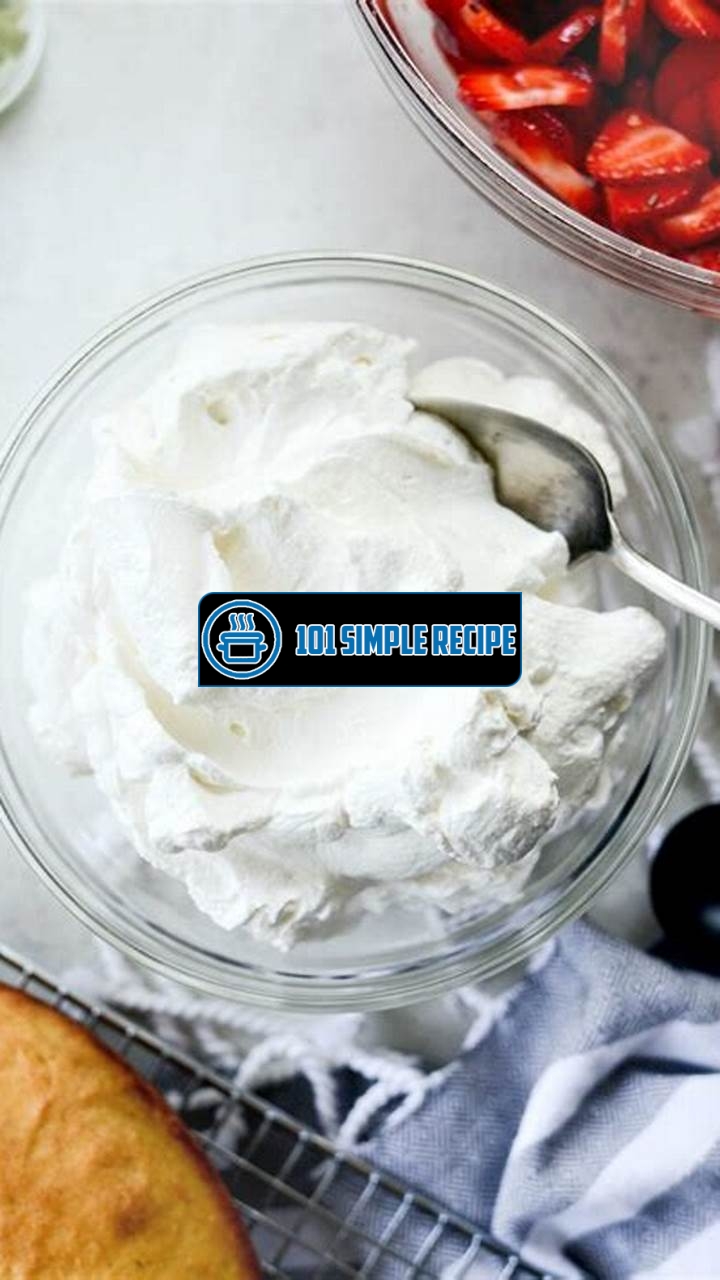Looking to add a dollop of sweet, airy goodness to your favorite desserts? Look no further than homemade whipped cream! ✨ With just one ingredient and a few simple steps, you can easily create this delectable treat. Whether you’re topping off a slice of pie or adding a creamy touch to your morning coffee, making whipped cream from heavy cream is a skill every home cook should have in their repertoire. In this article, we’ll guide you through the process of making fluffy whipped cream right in your own kitchen, so you can enjoy the delightful taste and texture of this versatile topping. So grab your whisk and get ready to whip up some magic! ✨

The Science Behind Whipped Cream’s Creaminess
When it comes to creating a light and fluffy topping for your desserts, nothing beats whipped cream. But have you ever wondered about the science behind its creamy texture and how it transforms from heavy cream? Let’s explore the chemistry behind whipped cream and uncover the secrets to achieving the perfect consistency.
The Composition of Heavy Cream
Before we delve into the process of making whipped cream, let’s first understand the composition of heavy cream. Heavy cream, also known as whipping cream or double cream, is a rich and fatty liquid that is derived from cow’s milk. It contains a high percentage of milk fat, typically around 36% to 40%. This high fat content is what gives heavy cream its velvety smoothness and richness. Additionally, heavy cream also contains water, protein, lactose, and various vitamins and minerals.
How Whipping Changes the Cream’s Structure
Whipping heavy cream is a transformative process that alters its structure, resulting in the light and airy consistency of whipped cream. The key to achieving this change lies in the fat globules present in the cream. When you whip heavy cream, the fat globules surrounding the air bubbles in the cream become entangled with each other, creating a network or matrix. This network traps the air bubbles and stabilizes them, giving whipped cream its volume and stability.
As you continue to whip the cream, the fat globules are further broken down, and the matrix becomes denser, resulting in a thicker cream. It is important to note that overwhipping can cause the fat globules to clump together excessively, leading to the separation of butterfat and buttermilk. So, it’s crucial to stop whipping once you achieve the desired consistency.
The Role of Chilling and Equipment in Whipping Cream
Chilling the heavy cream before whipping plays a crucial role in the process. When the cream is cold, the fat globules become more solidified and hold their shape better, making it easier to create a stable and fluffy whipped cream. It’s recommended to chill both the cream and the mixing bowl for optimal results.
Furthermore, the equipment you use also affects the outcome of your whipped cream. A cold mixing bowl and whisk or beaters are essential to keep the cream chilled during the whipping process. The cold environment helps maintain the stability of the fat globules, preventing them from melting and collapsing. So, be sure to use chilled equipment and work quickly to keep the cream cold as you whip it.
By understanding the science behind whipped cream’s creaminess, you can now confidently whip up a batch of fluffy goodness to top off your favorite desserts. Remember to start with high-quality heavy cream, chill your equipment, and stop whipping once you achieve the perfect consistency. With these tips in mind, you’re ready to create whipped cream that will delight your taste buds and impress your guests!
If you’re looking for more quick and easy recipes, try making a delicious cookie in a mug that you can enjoy in minutes.
Choosing the Right Heavy Cream for Whipped Cream
When it comes to making whipped cream, choosing the right heavy cream is crucial for achieving the best results. The quality and characteristics of the cream you use can greatly affect the texture and taste of the final product. Here are some factors to consider when selecting heavy cream for making whipped cream:
Fat Content and Whippability
The fat content of the heavy cream plays a significant role in its ability to be whipped into a light and fluffy texture. Creams with a higher fat content are ideal for making whipped cream as they provide better stability and volume. Look for heavy creams that have a fat content of at least 30%, as this will yield the best results.
In addition to fat content, the whippability of the cream is another important factor to consider. Whippability refers to the cream’s ability to hold its shape when whipped. Creams that are specifically labeled as “whipping cream” or “heavy whipping cream” tend to have the right balance of fat and other properties that make them ideal for whipping into fluffy peaks.
Important note: Be sure not to confuse heavy cream with light cream or half-and-half, as these have lower fat content and may not whip properly.
Ultra-Pasteurized vs. Regular Heavy Cream
Another consideration when choosing heavy cream for whipped cream is whether to use ultra-pasteurized or regular heavy cream. Ultra-pasteurization is a process that involves heating the cream at a higher temperature to extend its shelf life. While ultra-pasteurized cream has a longer expiration date, it can sometimes lack the necessary proteins and other properties required for proper whipping.
Important note: For the best results, it is recommended to use regular heavy cream instead of ultra-pasteurized cream. Regular heavy cream tends to have a better flavor and whips more easily due to its natural composition.
Organic vs. Conventional Heavy Cream
The choice between organic and conventional heavy cream is largely a matter of personal preference. Organic heavy cream is produced without the use of synthetic pesticides, antibiotics, or hormones, making it a more natural option for those concerned about potential chemical residues. However, it is important to note that the organic label does not necessarily guarantee better taste or quality when it comes to making whipped cream.
If taste is your main priority, conventional heavy cream may be a suitable choice. Conventional cream often undergoes pasteurization and other processes that can enhance its flavor and texture. Ultimately, the decision between organic and conventional heavy cream depends on your personal values and preferences.
Important note: Whether you choose organic or conventional heavy cream, make sure it meets the desired fat content and whippability requirements for making whipped cream.
By considering factors such as fat content, whippability, pasteurization method, and personal preferences, you can ensure that you choose the right heavy cream for making delicious homemade whipped cream. Happy whipping!
Secret Techniques for Achieving Perfectly Whipped Cream
When it comes to making whipped cream from heavy cream, achieving a light and creamy texture can sometimes be a challenge. However, with some expert tips and tricks, you can whip up the perfect batch every time. Let’s dive into the secrets of achieving whipped cream perfection!
Temperature Control for Optimal Whipping
One crucial aspect of making whipped cream is temperature control. Both the heavy cream and the mixing bowl should be chilled prior to whipping. This helps the cream hold its structure better and results in a fluffier consistency. To achieve optimal whipping, place the heavy cream and the mixing bowl in the refrigerator for at least 30 minutes before starting.
Additionally, make sure to whip the cream in a cool environment. High temperatures can cause the cream to become too soft and prevent it from properly forming peaks. So, choose a cool spot in your kitchen or consider chilling the room slightly to create the perfect conditions for whipping cream.
- Important Point: Chill the heavy cream and mixing bowl before whipping.
- Important Point: Whip the cream in a cool environment to prevent it from becoming too soft.
The Sweetness Factor: Adding Sugar to Whipped Cream
Whipped cream is not just about the creamy texture; it should also have the right amount of sweetness. Adding sugar to the cream not only helps it taste delicious but also stabilizes the whipped cream, allowing it to hold its shape longer.
Start by adding a small amount of powdered sugar to the chilled cream before whipping. This helps the sugar incorporate smoothly and prevents graininess in the final product. You can adjust the amount of sugar based on your preference, but remember that adding too much sugar can make the cream too sweet.
If you prefer a healthier alternative or are looking to reduce calories, you can use a natural sweetener like honey or maple syrup. These add a unique flavor to the whipped cream while still providing the desired sweetness.
- Important Point: Adding sugar stabilizes the whipped cream and enhances the flavor.
- Important Point: Use powdered sugar for a smooth texture and adjust the amount based on preference.
- Important Point: Explore natural sweeteners like honey or maple syrup for a healthier option with added flavor.
Adding Flavor Enhancements to Whipped Cream
While whipped cream is delicious on its own, adding flavor enhancements can take it to the next level. There are endless possibilities to explore, but some popular choices include vanilla extract, cocoa powder, and citrus zest.
To infuse your whipped cream with vanilla flavor, simply add a teaspoon of vanilla extract to the cream before whipping. You can also experiment with other extracts like almond or mint for a unique twist.
To create a chocolatey whipped cream, sift in a tablespoon of cocoa powder along with the sugar. This will give your cream a rich and decadent taste that pairs perfectly with desserts.
If you’re feeling adventurous, add a touch of citrus zest, such as lemon or orange, to your whipped cream. This adds a refreshing and tangy flavor that can elevate any dessert.
- Important Point: Enhance the flavor of whipped cream with vanilla extract, cocoa powder, or citrus zest.
- Important Point: Experiment with different extracts like almond or mint for unique flavor combinations.
By following these secret techniques, you can achieve perfectly whipped cream every time. Remember to control the temperature, add a touch of sweetness, and explore different flavor enhancements. Whether you’re topping off a pie or enjoying a bowl of fresh berries, your homemade whipped cream will elevate any dessert to a new level of deliciousness!
Common Mistakes to Avoid When Making Whipped Cream
Making whipped cream from heavy cream may seem like a simple task, but there are several common mistakes that can lead to less-than-perfect results. By identifying and overcoming these pitfalls, you can ensure that your whipped cream turns out light, fluffy, and delicious every time. Let’s take a closer look at three of the most common mistakes and how to avoid them.
Over-Whipping: The Danger of Stiff Peaks
One of the biggest mistakes you can make when making whipped cream is over-whipping. While it may seem like you need to keep whipping until you achieve stiff peaks, this can actually lead to a dense and grainy texture. Over-whipped cream loses its lightness and can quickly turn into butter.
To avoid over-whipping, it’s important to pay close attention to the texture of the cream. Stop beating as soon as soft peaks start to form. Soft peaks have a gentle curve and will hold their shape briefly before melting back into the mixture. This ensures that the whipped cream retains its light and fluffy consistency.
Remember, over-whipping can ruin your whipped cream, so be careful not to go too far!
Under-Whipping: Guarantees a Soupy Mess
On the flip side, under-whipping is another common mistake that can result in whipped cream that is too loose and runny. It may seem tempting to stop whipping as soon as the cream thickens slightly, but this will leave you with a soupy mess instead of the desired light and airy texture.
The key to achieving the perfect consistency is to whip the cream until it reaches firm peaks. Firm peaks stand upright when the beaters are lifted and do not collapse back into the mixture. This ensures that the whipped cream will hold its shape and provide a delightful dollop on top of your favorite desserts.
Keep in mind that under-whipping will leave you with a disappointing outcome, so whip until you reach those firm peaks!
Avoiding Issues with Sweetness and Flavor
While the texture of whipped cream is important, it’s also crucial to pay attention to the sweetness and flavor. Some common mistakes in this area include using the wrong type of sweetener or not adding any flavorings at all.
To avoid these issues, start by choosing the right sweetener. Powdered sugar is the best option since it dissolves easily and doesn’t leave a gritty texture. Adding a tablespoon of powdered sugar per cup of heavy cream is a good rule of thumb, but you can adjust the sweetness to your preference.
Additionally, consider incorporating flavorings such as vanilla extract or a splash of liquor. These additions can enhance the taste of your whipped cream and elevate it to another level of deliciousness.
Remember, sweetness and flavor are key elements of whipped cream, so don’t forget to add the right amount of sugar and your favorite flavorings!
In conclusion, by avoiding common mistakes like over-whipping, under-whipping, and neglecting sweetness and flavor, you can make perfect whipped cream every time. So, go ahead, grab your heavy cream, and whip up a batch of fluffy goodness to top off your favorite desserts!
To make whipped cream from heavy cream, you can follow this simple garlic bread stick recipe that will pair perfectly with your desserts.
Creative Whipped Cream Variations for Extra Deliciousness
Take your whipped cream to the next level by experimenting with unique flavors and textures. Adding a twist to your traditional whipped cream can elevate any dessert from ordinary to extraordinary. Get ready to tantalize your taste buds with these creative whipped cream variations!
Chocolate Lovers Unite: Cocoa-Infused Whipped Cream
If you’re a chocolate enthusiast, this cocoa-infused whipped cream will make your heart skip a beat. To make this indulgent treat, simply add cocoa powder to your heavy cream before whipping it to perfection. The result? A velvety smooth cocoa-infused heaven that pairs perfectly with brownies, cakes, or hot chocolate.
Tip: Sift the cocoa powder before adding it to the cream to prevent any lumps and ensure a silky, smooth texture.
Heavenly Citrus: Zesty Whipped Cream Delights
Add a burst of refreshing citrus flavor to your whipped cream with a hint of zest. Start by zesting a lemon, lime, or orange and then mix it into your heavy cream before whipping. This zesty twist will brighten up your desserts, adding a tangy and vibrant element that complements fruity treats like pies or tarts.
Tip: For optimal flavor, choose organic citrus fruits and grate only the outer colored part to avoid the bitter white pith.
Exquisite Elegance: Floral and Herbal Whipped Cream
Elevate your desserts with a touch of elegance by infusing your whipped cream with floral or herbal flavors. This sophisticated twist is perfect for special occasions or when you want to impress your guests. Experiment with lavender, rose, mint, or even basil by steeping the chosen ingredient in warm heavy cream. After straining, let it cool before whipping. The result is a delicate and fragrant whipped cream that pairs beautifully with desserts like shortcakes or fruit salads.
Tip: Use fresh or dried herbs and flowers from reliable sources to ensure the best taste and quality in your whipped cream.
Embrace your culinary creativity and let your dessert truly shine by incorporating these delightful whipped cream variations. Whether you’re a chocolate lover, a fan of citrusy delights, or someone who appreciates the elegance of herbal infusions, there’s a whipped cream flavor for everyone to enjoy. So go ahead and whip up a batch of these irresistible whipped cream variations and take your desserts to new heights!
For a delightful and versatile bread option, try making your own kaiser rolls using heavy cream as an ingredient.
Frequently Asked Questions
If you have any lingering questions about making whipped cream from heavy cream, we’ve got you covered:
| No. | Questions | Answers |
|---|---|---|
| 1. | Can I use any type of cream to make whipped cream? | While heavy cream is the best option for making whipped cream, you can also use whipping cream or double cream as alternatives. Just keep in mind that the fat content may vary slightly, which could affect the end result. |
| 2. | Should I use a stand mixer or hand mixer? | Either a stand mixer or hand mixer will work for making whipped cream. The stand mixer is more convenient for hands-free mixing, while the hand mixer allows for more control. Choose the method that suits your preference and kitchen equipment. |
| 3. | Can I make whipped cream ahead of time? | Yes, you can make whipped cream ahead of time. However, it is best to prepare it shortly before serving for the freshest and fluffiest results. If you do make it ahead, store it in the refrigerator and give it a quick whisk before using. |
| 4. | Can I sweeten whipped cream? | Absolutely! Sweetening whipped cream is a common practice. You can add powdered sugar, granulated sugar, or even flavored syrups to achieve your desired level of sweetness. Just remember to add the sweetener gradually and taste as you go. |
| 5. | How long does whipped cream last? | Freshly made whipped cream can be stored in the refrigerator for up to 24 hours. However, it may start to lose its texture and stability after a few hours. It is best to enjoy it shortly after preparing. |
| 6. | Can I freeze whipped cream? | Yes, you can freeze whipped cream. However, it may lose some of its fluffy texture and become slightly grainy upon thawing. It is recommended to freeze it in an airtight container and use it within 1-2 months for the best results. |
Thanks for Reading!
We hope this article has been helpful in guiding you through the process of making whipped cream from heavy cream. Now you have the knowledge and techniques to create a smooth and luscious topping for your favorite desserts. Remember to adjust the sweetness and flavor to your liking, and don’t hesitate to experiment with different variations. Keep practicing and soon you’ll be whipping up perfectly creamy delights. Be sure to visit us again for more culinary tips and tricks!
Jump to Recipe
How to Make Whipped Cream from Heavy Cream

Learn how to make homemade whipped cream using heavy cream, a versatile and delicious topping for desserts.
- Heavy cream
- Powdered sugar
- Vanilla extract
- Before you begin, make sure to chill the heavy cream in the refrigerator for at least 30 minutes. This will help it whip up more easily.
- Pour the chilled heavy cream into a mixing bowl. Using a hand mixer or stand mixer, start whisking the cream on low speed. Gradually increase the speed to medium-high. Whip the cream until it thickens and soft peaks form.
- Once the cream has thickened, add powdered sugar and vanilla extract. Start with a small amount and taste the cream. Add more sweetener or flavoring if desired. Continue whipping until the cream reaches your desired consistency.
- Transfer the whipped cream to a serving dish or use it immediately as a delicious topping for your favorite desserts. Enjoy the creamy goodness!






